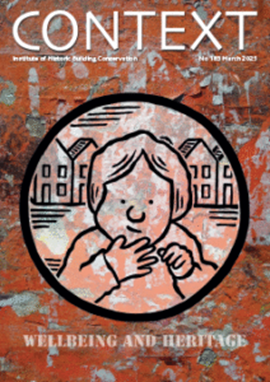Purbeck stone
Purbeck Stone, Treleven Haysom, Dovecote Press, 2020, 312 pages, over 350 colour and black-and-white illustrations, hardback.
For those of us who have not spent a lifetime working with a particular building material, the next best thing is to learn from someone who has. Treleven Haysom is the 11th generation of his family to have worked in the stone industry on the Isle of Purbeck, Dorset. His book is a chance to immerse ourselves in the stones and their uses.
Why did the quarrymen rarely whistle? ‘My father thought the aversion to whistling lay in the fact that sometimes as a ceiling bed separates there can be a sucking sound,’ Haysom writes. ‘It was something best to be on the alert for.’ Knowing what you were doing in this dangerous industry could be a matter of life and death. Most beds were hacked out from below, the upper beds being supported by leaving just enough stone in place, or building supporting columns and walls.
Accessed from the cliffs or by digging down, the beds produce a variety of types of stone that is wide in both quality and thickness. Thicker beds provide building stone, while shallower ones are suitable for paving and the thinnest for roofing.
Much Purbeck stone is a warm, yellowy-brown colour when it is first quarried, weathering to a softer, greyer tone. Many of the rocks were built up from the sediment of a few species of clams, oysters or snails, which can be seen clearly. Many (much more than those of nearby Portland) are also characterised by calcite veins, locally called ‘lists’, caused by stress to the rocks over millions of years. The caption to one of the photos refers to another type of stress: ‘Note nearest long roofing slab, heavily distorted by dinosaur trampling.’
The stone from beds of so-called Purbeck marble are hard and polishable, although many other Purbeck beds that are equally hard and polishable are known by other names. The darker marbles were particularly valued for their decorative uses in medieval architecture.
Haysom is particularly good at explaining the specialised language of the quarrymen, some of which changed in meaning over the years. By the end of the book the reader will find that a quoted comment such as ‘Ruggle ’im round on banker til the back’s lookin’ at yer, then tother side’s the face’ makes perfect sense.
He explains how the various stones perform in buildings. Used locally, the stone in this seaside location tends to become saturated by salt, whose crystals damage the stone by expanding in confining pores. ‘If fully exposed to drenching rain the stone lasts well,’ he writes, ‘but, paradoxically, if somewhat sheltered, damage occurs.’
The author draws on a lifetime of quarrying and masonry work, a deep knowledge of the industry’s working and oral traditions, and years of research. The story is well told in immense and fascinating detail, and superbly illustrated with photographs, maps, diagrams, plans, paintings, drawings and engravings.
This article originally appeared as: ‘Trampled by dinosaurs’ in Context 169, published by the Institute of Historic Building Conservation (IHBC) in September 2021. It was written by Rob Cowan, editor of Context.
--Institute of Historic Building Conservation
Related articles on Designing Buildings
IHBC NewsBlog
Old Sarum fire in listed (& disputed) WW1 Hangar - Wiltshire Council has sought legal advice after fire engulfed a listed First World War hangar that was embroiled in a lengthy planning dispute.
UK Antarctic Heritage Trust launches ‘Virtual Visit’ website area
The Trust calls on people to 'Immerse yourself in our heritage – Making Antarctica Accessible'
Southend Council pledge to force Kursaal owners to maintain building
The Council has pledged to use ‘every tool in the toolbox’ if urgent repairs are not carried out.
HE’s Research Magazine publishes a major study of the heritage of England’s suburbs
The article traces the long evolution of an internal programme to research 200 years of suburban growth
IHBC Context 183 Wellbeing and Heritage published
The issue explores issues at the intersection of heritage and wellbeing.
SAVE celebrates 50 years of campaigning 1975-2025
SAVE Britain’s Heritage has announced events across the country to celebrate bringing new life to remarkable buildings.
IHBC Annual School 2025 - Shrewsbury 12-14 June
Themed Heritage in Context – Value: Plan: Change, join in-person or online.
200th Anniversary Celebration of the Modern Railway Planned
The Stockton & Darlington Railway opened on September 27, 1825.
Competence Framework Launched for Sustainability in the Built Environment
The Construction Industry Council (CIC) and the Edge have jointly published the framework.
Historic England Launches Wellbeing Strategy for Heritage
Whether through visiting, volunteering, learning or creative practice, engaging with heritage can strengthen confidence, resilience, hope and social connections.















